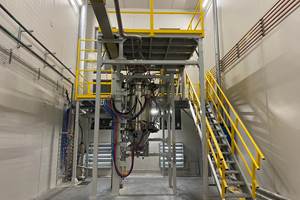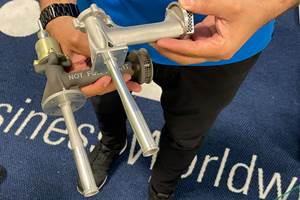3D printed composite materials such as carbon-fiber reinforced polymers can have temperature, mechanical and chemical resistances that are similar enough to metals that they can replace metal parts in some situations. During our AM Radio podcast segment about these applications, Stephanie Hendrixson and I realized that composite parts are replacing metals in one specific niche: aerospace training devices, such as flight simulators and maintenance trainers.
Listen to the episode above or see the transcript below to find examples of these applications we’ve encountered, as well as our discussion about expanding the use of 3D printed composites in the aerospace industry.
Julia Hider
How can 3D printed composites provide an alternative for metal parts? And how could blockchain and additive manufacturing work together to transform supply chains? Find out more on this episode of a AM Radio.
This episode of The AM Radio podcast is brought to you by CompositesWorld, a sister media brand to Additive Manufacturing Media. For information on what's happening in fiber-reinforced composites manufacturing, visit compositesworld.com.
Welcome to AM Radio. I'm Julia Hider. And today I'm here with Stephanie Hendrixson. Hey, Stephanie.
Stephanie Hendrixson
Hi, Julia.
Julia Hider
So I wanted to start off by talking about the shop visit I went on recently, because I think it fits into a larger trend I'm seeing of 3D printed composites replacing metal parts. So I was in Tulsa a few weeks ago, and one of the shops I visited was Werco Manufacturing. They mostly do aerospace parts, and one of their specialties is making training devices or trainers for commercial and military aircraft. And the ones they make are for everything behind the cockpit. So they're not making flight simulators. But they could be for things like landing gear maintenance, or training flight attendants. And sometimes these trainers can be really large and complex. Just to give an example, they took me out onto their shop floor, the first thing I saw was a whole airplane fuselage. I think it was like a Boeing 737. And they were working on modifying it into a training device. But they can also be as small as a few parts assemblies, but either way, the customers want the trainers to be as close to the actual aircraft as possible. So we're go usually starts with salvaged aircraft, and then it modifies it as needed. But there are a lot of challenges to working with salvage, it's getting harder to come by because of extended aircraft life cycles. And the market for it moves really fast. And there are really long lead times for it. Enter 3D printing, it's a really good fit for this application, because it's low-volume or one-off work. But the shop wasn't ready to get into metal 3D printing. And they were concerned that polymers like ABS and PLA weren't going to be able to hold up and function like metal. So they brought in two Argo 500 3D printers from Roboze that can print high-performance materials like PEEK or PEEK that's reinforced with carbon fiber. And these materials can stand up to the wear and tear of a new trainee, like forcing a part that they shouldn't. So I was wondering if you have any other examples that you've seen recently of composites replacing metal parts?
Stephanie Hendrixson
Yeah. So it's funny that you mentioned flight simulators, specifically as something Werco doesn't do. Because I have seen a 3D printed flight simulator—
Julia Hider
And it's composite?
Stephanie Hendrixson
And it's composite!
Julia Hider
Amazing. Now we can have a full 3D printed training for an airplane.
Stephanie Hendrixson
Yeah, so towards the end of last year, maybe Pete and I and our videographer, Austin went up to Additive Engineering Solutions in Akron, Ohio. And they have a couple of those Big Area Additive Manufacturing (BAAM) machines. They mostly do tooling, but this was one of their first production jobs. There's this other company L3Harris that produces flight simulators. And they were in the position of like assembling these things from literally thousands of parts. They would get these parts from all over the place and put them together. And a lot of it was things like machined components, bent sheet metal, different metal fasteners that like, there's just a lot of metal that had to come together. The solution that they found with AES was to have AES use their giant printers to print kind of the body of the flight simulator. And they do it in a couple of pieces, and then they machine it. So the surface finish, it looks really nice. And as actually does some of the assembly work for them now. And so they've gone from literally putting together thousands of parts to putting together a few hundred. The material that they're using to print these is a chopped-fiber ABS. And so yeah, it is a case of 3D printed polymer composite being used to replace sheet metal.
Julia Hider
It's interesting that you brought up how they machined the 3D printed flight simulator, because that's something that Werco was talking about as an advantage of working with the composites as well, you know, you can't machine ABS or PLA, it'll just, you know, completely deform. And so because they can machine the carbon fiber PEEK, it allows them to make parts with tighter tolerances, and that also helps them in replacing metal parts because they can get it tighter tolerances more in the range of a machined metal part.
Stephanie Hendrixson
Yeah. And something else I noticed in looking through your story was they actually go a little bit beyond that and finishing you want to talk about some of the other processes that happen to these parts?
Julia Hider
Yeah, so I visited the shop right after you release the episode you did with Scott Francis of Products Finishing and I go into the shop and they're talking about how they're painting and powder coating these composite parts and I was very excited because I had just listened to you talk to him about that. Yeah, the painting allows them to you know, print larger components in smaller pieces and then assemble them into a bigger part and then paint it because the PEEK and the current PEEK can withstand the higher temperatures, they can go into a paint booth with no problem. And they don't need to worry about them deforming and the heated paint booth and the carbon peak can actually withstand temperatures that are high enough that allow it to be powder coated. So I get to see a couple of powder coated 3D printed parts as well.
Stephanie Hendrixson
In the case of Werco, and I think L3Harris a little bit, 3D printing becomes a solution to this problem, because it's low volume. It's not something that's needed in great quantities. But you know, maybe you need to replace some of these parts after they go through training. And you know, somebody forces it into the wrong place. And then you just have a digital file, you can print another one, you're not having to go through the salvage process and try to find what it is that you need. Does the strength of the material play into this at all for Werco?
Julia Hider
Yeah, so as far as the trainer's the strength isn't necessarily as important, but what they would like to do is eventually translate this into 3D printing composite parts that will go on actual aircraft. So they mentioned it when I was talking to them that Tinker Air Force Base in Oklahoma City put out this list of spare parts, it's a 70-page Excel spreadsheet of parts that they can't get. And they believe that the mechanical and chemical and temperature properties of the carbon fiber peak will allow that material to work in an aircraft. But the problem is that there's no way to get these parts approved with these new materials. So that's something that they're working on right now. And, you know, hopefully, they will have a solution for that soon.
Stephanie Hendrixson
Yeah, the regulation side is a really big deal for additive, especially in the aerospace industry. So it's interesting that they are thinking about how these 3D printed parts could ultimately go on an aircraft. I've actually seen an example where we put this to the test on The Cool Part Show.
Julia Hider
Oh, yes, tell us more.
Stephanie Hendrixson
So we did an episode with a company out of Switzerland, they're called 9T Labs. It's sort of a hybrid process, like it's 3D printing, but also molding. So they have a printer that applies a thermoplastic. So like, usually, I think they use PEEK and then continuous carbon fiber at the same time. And so they build up the part by printing with this thermoplastic using the carbon fiber just in the places where it needs reinforcement. And then they take those pieces and put them through a compression molding step. And that kind of like solidifies the whole thing. So it behaves like a more conventional composite. And the part that they gave us for the show was this bracket for a helicopter door hinge. And so they sent us the machined steel version of this bracket, and then also some of the 3D printed ones. So we talked about how they were both made. And then my dad actually helped with the show. And we did a lift test where it was like 900 pounds of steel beam, one bracket on either end, and we lifted it. And both of them held their side of the the beam just pass the test. You know, we didn't take it to its breaking point. But it did hold up to what they said it should have.
Julia Hider
And so are these brackets being put on helicopters right now?
Stephanie Hendrixson
I don't think so right now. And probably some of it is like that, that whole regulation process that has to come with aircraft, but I know that they are exploring this. And they're looking at applications in multiple different industries where there's like a small metal part that could be replaced by a composite that's going to be lighter, maybe faster and easier to manufacture too.
Julia Hider
So yeah, it sounds like right now, 3D printed composites replacing metals are good for aerospace training devices specifically, and we will stay tuned to see how the regulations change and see if we can get them on actual aircraft in the future. Alright, that's a good place to wrap up this conversation. Stay tuned for our discussion of blockchain and additive manufacturing.
Related Content
At General Atomics, Do Unmanned Aerial Systems Reveal the Future of Aircraft Manufacturing?
The maker of the Predator and SkyGuardian remote aircraft can implement additive manufacturing more rapidly and widely than the makers of other types of planes. The role of 3D printing in current and future UAS components hints at how far AM can go to save cost and time in aircraft production and design.
Read MoreDrones Take Flight with Metal and Polymer 3D Printed Parts: The Cool Parts Show Bonus
Drones produced by Cobra Aero now incorporate many 3D printed parts made through laser powder bed fusion and Multi Jet Fusion processes.
Read MoreCan the U.S. Become Self-Sufficient in Aerospace Alloy Metal Powders?
6K’s technology can upcycle titanium and nickel-alloy parts into additive manufacturing powder. Here is how the circular economy helps national security.
Read MoreQualification Today, Better Aircraft Tomorrow — Eaton’s Additive Manufacturing Strategy
The case for additive has been made, Eaton says. Now, the company is taking on qualification costs so it can convert aircraft parts made through casting to AM. The investment today will speed qualification of the 3D printed parts of the future, allowing design engineers to fully explore additive’s freedoms.
Read MoreRead Next
How Additive Manufacturing Can Benefit from Blockchain: AM Radio #15B
Blockchain technology isn’t only suitable for protecting cryptocurrency and NFTs. This week’s episode of the AM Radio podcast looks at how blockchain is being applied to 3D printable files today, and how far this pairing could go.
Read More3D Printing Brings Sustainability, Accessibility to Glass Manufacturing
Australian startup Maple Glass Printing has developed a process for extruding glass into artwork, lab implements and architectural elements. Along the way, the company has also found more efficient ways of recycling this material.
Read MoreAt General Atomics, Do Unmanned Aerial Systems Reveal the Future of Aircraft Manufacturing?
The maker of the Predator and SkyGuardian remote aircraft can implement additive manufacturing more rapidly and widely than the makers of other types of planes. The role of 3D printing in current and future UAS components hints at how far AM can go to save cost and time in aircraft production and design.
Read More






















